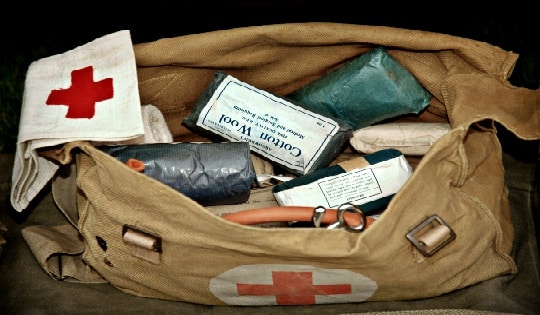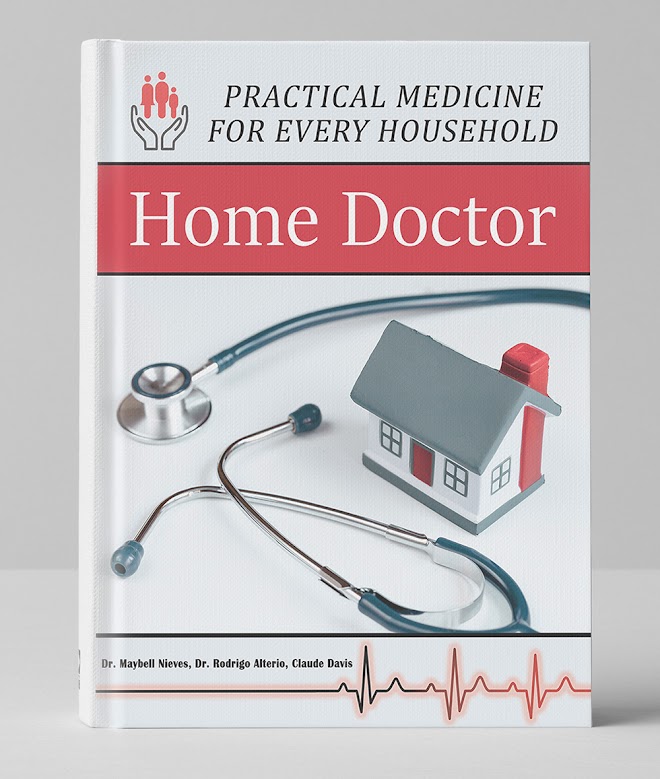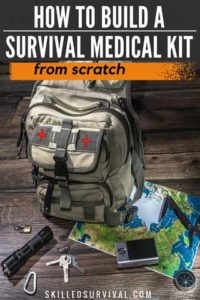
Ask any search and rescue member what they’d do in a serious emergency, and they’ll give you two simple answers:
- Carry a medical kit AND
- Actually know how to use it.
It’s not enough to just have the gear—it’s all about being prepared to use it when you need it most.
Trust me, knowing how to stop a bleed or stabilize an injury could be the difference between a close call and a disaster. So, stock up, study up, and stay safe!
Best Survival First Aid Kits On The Market Today
High-quality first aid kits can be hard to find at the right price, especially for the really great ones. But we’ve done a ton of research to find them anyways.
Here are several high-quality, professional kits ready for any survival scenario:
If you want the best first aid kits money can buy, look no further than MyMedic.
The team at MyMedic has perfected the art of putting together the perfect medical kits - from Solo kits to first aid kits - all the way up to full-fledged Medical Kits.
They've even crafted specialty kits for surfing, boating, and firearms with their Boat Medic, Surf Medic, and Range Medic Bags.
Heck, they even have a Pandemic Medic Kit you can buy!
Now, I recommend the MyFAK Kit or the Recon Kit.
Both are light enough to carry around but have all the necessary supplies to tend to most medical emergencies.
And what I like about ALL the MyMedic Kits is how much attention to detail they give to organization and quality.
You won't find cheap supplies or tools in these bags - meaning they are worth every penny!
Here’s a thorough video review of MyMedic’s (FAK) First Aid Pack:
↓ My Medic IFAK Kit Review
Every component in this survival kit is meticulously labeled.
This helps you identify each item and what it should be used for.
This helps prevent rummaging through your first aid kit for non-existent or outdated items!
The first aid kit bag is water-resistant and durable, with strong zippers and double-stitched handles.
Belt loops and reflective piping also help find the kit in the dark.
This small first aid kit is made out of 600D Polyester.
Making it one of the strongest bags in its price class.
This kit includes large stainless steel scissors that can quickly cut through clothing or seatbelts.
The kit has 100 essential basic life-saving items but only weighs 1 pound.
It's small enough to fit into your car’s glove box.
It also includes MOLLE-compatible straps on the back.
This allows you to add to larger bags or your belt.
The water-resistant bag and waterproof inner laminate bags protect all items from moisture.
If you're looking for a complete EMT Trauma Bag without the hassle of building it yourself, this First Responder Bag by Lightning is about as good as it gets.
This bag has everything you can think of organized and ready to go.
However, if you're new to medical emergencies and survival, this bag has way more medical gear than you need (or even know how to use).
The biggest perk of this small pack is the waterproof container, which comes with QuickClot, gauze, a trauma pad, triangle bandages, and more.
This adventure kit is designed to respond quickly to control bleeding at the scene before seeking more advanced care.
Making it ideal for major trauma in combat and everyday situations.
Durable, waterproof, and reusable packaging will stand up to abuse in the outdoors.
Emergency response supplies are packed in this sturdy medical kit.
Making it an ideal medical kit for natural disasters (Earthquakes, Tornados, Hurricanes, etc.)
This bright reflective bag has several large compartments.
- 2 front pockets
- 2 zippered side pockets
It includes basic first aid supplies, blood pressure cuff, stethoscope, gauze pads, burn gel, eye wash, triangle band-aids, & multi-trauma blood stop dressing.
It contains enough first aid supplies to treat any basic emergency.
How To Build A First Aid Medical Kit From Scratch
Call it what you like:
- Medical Kit
- DIY First Aid Kit
- Survival Medical Kit
- Prepper Medical Supplies
The specific name doesn’t matter…
What matters is:
You have one in a time of need.
So by following this guide you’ll have everything necessary to build an emergency medical kit for survival.
Some of the first aid supplies listed will include advanced medical supplies. These ARE above what a medical novice needs.
But if you follow the first aid list to a T, you’ll be prepared for nearly any medical problem. And IF you need it, you’ll be grateful you did.
Choosing The Right Medical Bag
Collecting contents is the second step in building your own first aid kit.
First, you need a pack to put all the supplies in. Whether you use a bag, a box, a basket, or an entire emergency vehicle…
You must store your meds and supplies as orderly as possible. Which requires a meticulous approach.
How will you one to suit your needs?
- Will you be storing yours in a home or a car?
- Is this something you’ll want to carry places?
- How durable does your med kit need to be?
- How thorough?
Size, shape, weight, and intention are important factors.
For example:
- If you are rafting down the Grand Canyon, you need a waterproof bag that easily transport between rafts.
- If you are going on a backpacking trip through South East Asia, you will need something small, light, and packable
Wilderness Responders use small duffle bags or full-on survival backpacks for their kits.
Choosing the RIGHT container may seem mundane. But the choice carries a lot of weight.
Here are some of the best medical bags for your kit:
A Unigear Dry Bag is ideal for building a medical kit for wet environments.
A regular medical bag just won't cut it in environments such as rafting, boating, or any water adventure or sport.
Why? Because they are completely waterproof.
Perfect for stashing medical supplies in extremely wet or humid environments.
This is a compact 1000D anti-abrasion polyester bag.
It's a MOLLE-compatible pouch for emergency or tactical situations. And it is a perfect addition to your bug-out bag.
It has a tri-fold design with a rip-away Velcro panel.
It has a wide handle for removal or carrying.
The compact pouch also includes a pair of quality EMT shears.
The MedPac 3800 is not just a bag you convert into a medical kit bag.
Instead, it is a bag made to be a medical kit.
So its compartments are made for medical supplies and keeping it all organized.
The spacious main compartment has 5 adjustable dividers to organize larger supplies and equipment.
The MedPack 3800 has an adjustable buckle assembly that keeps the full-access lid upright for visibility and access.
A gusseted front pouch has multiple instrument pockets and elastic loops.
The MedPac 3800 is water-resistant Ballistic Nylon with thick foam padding for shape and structure.
Yes, it's not cheap, but this is a serious bag for a serious medical kit build.
If the MedPack 3800 gave you sticker shock. Consider this large 22" tactical duffel bag instead.
No, it's not specifically made for medical supplies, but you can make it work at this more affordable price point.
Regardless of the bag you prefer (duffel/backpack/etc.), make sure it's tactical.
There are several medical boxes out there that are highly durable and great for staying organized.
The Family Emergency Kit Storage Box is made out of durable plastic.
It also includes an organizing divider tray to help keep small medical supplies from getting mixed up.
It's a nice family emergency medical kit you can stash in a closet.
A military medic backpack is one of the most functional containers for a survival medical kit.
The number of pockets and high durability make them extremely functional options.
This "go anywhere" design is perfect when a larger pack is too big, bulky, and heavy.
This pack can fit many medical tools and supplies but is not so big to become cumbersome.
It can also be worn in 3 configurable ways (across the back, chest, or hand carry).
This is a MOLLE-compatible pouch and has 3 zippered compartments.
It's the right size, shape, and design to make an excellent portable survival medical kit.
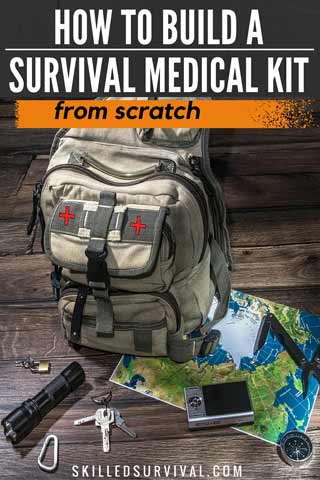
Want a free survival medical kit checklist?
Enter your email below to instantly download this Complete Checklist PDF. No purchase necessary. 👇 👇Survival First Aid Kit List
Start with the basics.
From diarrhea to headaches – from inflammation to minor infections… The basics will be the most frequently used items in your kit.
So they should be the most accessible as well. Make sure to pack extra.
These supplies can be bought at drugstores, pharmacies, or even online.
Basic Medical Care Tools
Tweezers are a commodity. But tweezers are NOT created equal…
Cheap $2 tweezers are NOT good enough for your medical kit.
Upgrade to these tactical tweezers to easily remove hard-to-get-at splinters and foreign objects.
Non-Contact Infrared Thermometer
You should look for a non-contact infrared thermometer.
You want non-contact if you ever plan to use this in the field, especially during a pandemic.
And infrared makes getting a reading as easy and painless as possible, especially with small children.
Trust me: Holding a thermometer under your kid’s tongue, armpit, or rectum should be a hassle of the past.
When time is of the essence (and what medical emergency isn’t), you’ll want to get that temp fast.
So invest in a thermometer like this one.
Go online for a nice bulk discount.
The Anti-Bacterial Q-Tips add an additional layer of cleanliness.
Large Trauma Shears
These high-quality EMT shears feature a special coating.
This provides a non-stick surface for your emergency cutting needs.
It includes sharp edges and milled serrations for cutting through the toughest material.
Surgical Grade Toenail Clippers
These surgical nail clippers can handle even the thickest toenails due to diabetes, psoriasis, or fungus.
They are sharp, ergonomically designed, and made of stainless steel to prevent rusting.
They also come with a lifetime guarantee.
So these are the last pair of toenail clippers you’ll ever buy.
Because there are some medical tasks where nail clippers are the only tool for the job.
Scalpel with Blades
A sharp scalpel will do for basic medical emergencies.
But if you’re looking for something more advanced, get a suture kit.
Stethoscope
The price range of stethoscopes is extreme.
It’s hard to believe, but the more advanced ones are several hundred dollars.
But unless you’re an EMT or a physician, a standard stethoscope (like this one) is all you need.
Over-The-Counter Medications (Recommended numbers included)
Next up is the list of over-the-counter medications:
- Ibuprofen (pain relief), 20+
- Acetaminophen (Tylenol), 15+
- Aspirin, 15+
- Anti-histamine, x10
- Immodium/Loperamide, x10
- Sudafed (or an equivalent), x10
- Throat lozenges, 10+
- Bismuth tabs, x20
- Oral rehydration, x3
- Cranberry extract, x10
- Dramamine, x10
- Stool softener and/or Laxative, x15
Note: If you are uncertain what each does, click the link to find more specific information about each recommendation.
Lotions and Creams
You should ass some medical creams to your first aid kit.
These allow you to keep wounds clean and free from infection, control minor rashes, reduce inflammation, stop fungus growth, etc.
- Antibiotic ointment (Neosporin or equivalent)
- Hydrocortisone
- Miconazole/Anti-fungal
- Anti-Bacterial Bar Soap (for wound cleaning)
Advanced Wound and Trauma Supplies
This is where more advanced survival medical training comes in handy.
Treating wounds is not always a simple ordeal – especially trauma. And it’s often a job that is best left to the professionals. But in a survival situation, you may be responsible for treating these injuries to the best of your ability.
Realistically, no one is prepared for every medical emergency outside of a hospital. Wounds can be ugly. Trauma can be horrifying! But here are some tools that will help prepare you for both:
Blister Treatments:
- Molefoam
- Moleskin
- 2nd skin
- Medical tape
Wound Treatments (Recommended numbers included):
- Nitrile gloves, 4+ pairs
- Irrigation syringe
- Sterile gauze pads, 5+
- Band-Aids, 20+ (various sizes)
- Alcohol / Antiseptic wipes, 15+
- Ace Elastic Bandages, x2
- Triangle bandages, x2
- Tegaderm, x2
- Steri-strip or butterfly closures, 3+
- Sam-splint moldable foam splint
- Israeli Compression bandage
- Suture kit
- Iodine
- Tourniquet
Popular Prescription Medication
Anyone seeking to build an advanced kit should consider including prescription medications.
These drugs require an advanced understanding of medicine to administer.
But if you have access to these supplies it could save a life:
- Epinephrine 1mg: Treats severe allergic reactions.
- 1ml small syringe with needle
- Ciprofloxacin 500mg: Treats infections also given to individuals exposed to anthrax.
- Azithromycin 500mg: Treats atypical mycobacterial infections and bacterial infections of the heart valve.
- Bactrim d.s. 160/800mg: Treats bacterial infections
- Amoxicillin 500mg: Treats infections or stomach ulcers.
- Flagyl 500/400mg: Treats bacterial infections.
- Fluconazole 100mg: Prevents and treats certain fungal infections.
Misc. Medical Supplies
- Asthma Inhalers: Albuterol is a basic prescription drug for people with difficulty breathing.
- Vitamins: Pack your favorites, or pack them all. Multivitamins are handy for saving both space and weight.
- Epinephrine: Mentioned before in the prescription section. Epinephrine is a medication for severe allergic reactions. It usually requires a certification to administer to another person (except in the case of a life-threatening emergency).
- Small toy or puzzle: Children can be distractions, and in medical emergencies, they can often be a danger to themselves. Keeping a small toy or puzzle to calm a child down or to offer comfort can be as good as any medication for agitation or distress. It can sometimes even work with adults.
- Toiletries: Just a razor, deodorant, a toothbrush, and toothpaste can make a huge difference in survival. Having extra hygiene supplies never hurts.
- Purell
- Sunblock
- Aquamira or other iodine tablets (for water purification)
- Bug repellent
- CPR pocket mask
- Survival lighter and waterproof matches
Medical Kit Packing & Storage Strategies
Keeping an organized kit is important.
In a medical pinch, time is of the essence.
Neither patient nor the caretaker can afford to waste any time sifting through a sack full of unlabeled supplies.
Preparation is everything. Divide your kit into a few general categories.
There are several ways you might approach this. But one effective example is to separate the contents:
- Trauma
- Prescription medication
- Over-the-counter medication
- Personal supplies
Trauma kits and supplies are typically required in urgent scenarios.
So, keep them stored in an easily accessible part of your med kit.
Here are several ways to keep these categories separate and organized:
Separate The Compartments
It may be as easy as using the existing compartments of your container (like in a medic backpack or utility box) to separate your categories.
These come in assorted sizes and colors. Making them ideal for color coding and storage.
Most are made from water-resistant material, extremely durable, light, and highly packable.
They are available at almost any outdoor retailer, surplus store, or online.
Tupperware
This works well for those less concerned with their space and weight.
These also come in different sizes, shapes, and colors for storage and color coding.
Additionally, Tupperware is relatively cheap and accessible anywhere with a grocery store.
Zip Lock Bags
These are excellent for a variety of functional purposes.
They can be used for arranging and labeling drugs or different sizes of adhesive bandages.
Use a Sharpie to label them clearly. Zip-lock bags are also effective at containing spills.
So that leaky soap or iodine bottle doesn’t taint the rest of your emergency survival kit.
A good rule of thumb: Keep it in a zip-lock bag if it leaks.
Pill bottles
These bottles are great for storing medication.
They are also extremely useful for keeping Band-Aids and other small components organized.
They are cheap, reusable, and recyclable.
Keeping Your Kit Updated
So, the contents have been acquired and organized.
The container has been chosen and packed.
And you are prepared to deal with a medical emergency to the best of your ability. But the work doesn’t stop there.
Much like a plant, or a pet, your medical kit needs regular attention and updates.
Medicines expire, and it serves no one if everything in your survival med kit has gone bad by the time you need it. Be sure to check for expiration dates systematically.
Occasionally, container seals fail, and leakage amongst your supplies is bad.
It helps to unpack and repack your entire kit once every few months to take stock and replace.
Some may find it useful to create their own first aid list and keep it in their kit at all times.
This can help track what you do and do not have, how much you’ve got, and when certain medications expire. Devise a system for this step.
Maintaining and updating your kit is critical, even if you tend to be sloppy.
Be scrupulous, and you’ll be prepared.
Below is a long but extremely detailed DIY Tactical Medical Kit Build video.
It may be more advanced than what you’re looking for, but you’ll learn a ton about building a medical bag:
↓ Tactical Medical Bag: Medium-Sized Group

Want a free survival medical kit checklist?
Enter your email below to instantly download this Complete Checklist PDF. No purchase necessary. 👇 👇Developing Your Survival First Aid Kit
Medical experience is an extremely helpful accessory to this project, but it’s not a skill set that everyone has.
The most important part of building a medical kit is understanding how to use what’s inside.
- You could enroll in an EMT course at your local community college.
- Or you could sign up for Wilderness First Responder training.
Both of those options are excellent if you have money and time.
You could also take a CPR class or two or even get your hands on something as simple as “Basic First Aid” or even “Medicine For The Outdoors.”
Just make sure to read it cover to cover. But I recommend you check out the medical information product called The Home Doctor.
Home Doctor Book
It’s the only complete medical survival guide for the laymen (like you and me).
It shows you how to treat yourself and your loved ones in an emergency when doctors, pharmacies, and hospitals are shut down.
It’s a straightforward medical book. And you don’t need any medical training…
Plus, there’s no need for a medical professional to look over your shoulder. And here’s the best part:
You won’t need to spend a bucket of cash or waste weeks poring over weird medical terms!
It’s so easy; a 12-year-old can understand it.
You’ll be amazed by the difference it makes to know how to use your medical supplies in a pinch.
↓ Home Doctor Book Review – Is It Worth Buying?
Good Luck
Unfortunately, it is no cheap way to prepare for a medical emergency.
Whether you buy a pre-made medical kit, build one of your own, or buy one that you improve upon, it will likely cost you. But a well-built first aid kit will be worth it.
Because a prepared future is a worthwhile investment.
Under the luckiest circumstances, your new kit will gather dust where you store it.
Hoping it remains unused for decades…(though well-updated). Emergencies are never fun, especially when it involves severe trauma. And any day you have to break out med kit is a bad day.
The best precaution is safety; the best way to stay safe is to stay prepared. Good luck out there.

Prepare, Adapt & Overcome,
P.s. - I just found out 2 out of 3 Americans don’t feel prepared for a 3 day disaster!!!
I guess this goes to show how modern society continues to embrace ‘living a fragile life.’ What’s crazy is… it’s so easy to fix.
To make sure YOU have the basics, watch our FREE training on “10 Simple Steps To Basic Preparedness” that shows you HOW.
Nothing crazy here… this isn’t doomsday prepping... just the basics every responsible adult should have before a disaster strikes.Why You Can Trust Skilled Survival...
Go here now to review a full breakdown of:
- Who We Are
- Our Credentials
- Our Mission
- & Product Recommendations...
Here are a few highlights of our teams credentials & certifications:
- Certified Member of a Mountain Search & Rescue Organization
- Plant Emergency & Safety Leader for a Major Food Manufacturer
- Member of the 10TH Mountain Division Hut Association
- Certifications: Avalanche 1, WFR, CPR
- Official Gear Tester for Numerous Outdoor Gear Companies
- Countless Multiday Backpacking trips into Remote Wilderness
- Bachelor's Degree In Mechanical Engineering
- Bachelor's Degree In Civil Engineering
- Bachelor's Degree In Biomedical Engineering
"It takes 20 years to build a reputation and five minutes to ruin it." - Warren Buffett
We're fully aware that trust is NOT something you GET but is EARNED.
And we'll continue to earn YOUR trust through our forthright and honest approach with each new Blog Post, Guide & Product we create...
P.s - I just took this FREE 60-second 'Readiness Score Quiz'👇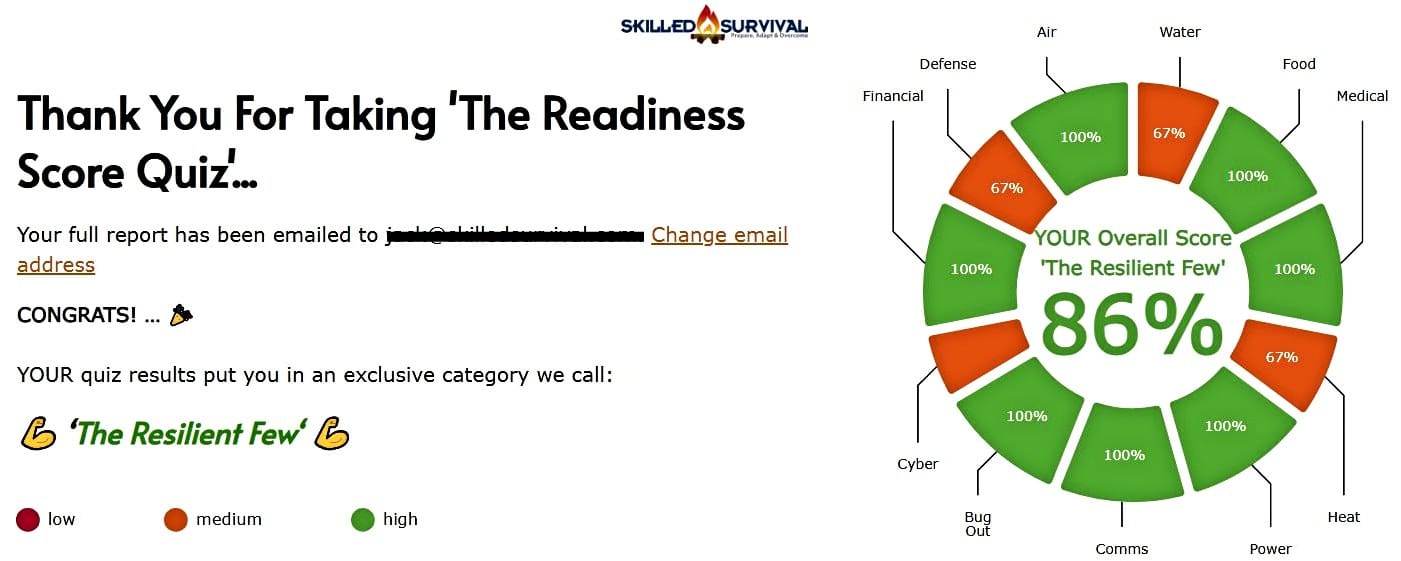
AND... I've still got a few gaps in my preps...🤔 But at least, I'm not part of 'The Fragile Masses'. 👍 Find out where YOU stand by answering a few questions...
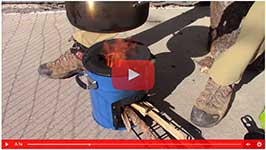
Recommended Reading
Survival Pack: How To Build One NOW (before SHTF)
A complete list of critical items that need to be in your survival pack before heading out into the wilderness.
Survival Packing List: Best For An Evacuation
Everyone needs a survival packing list to organize their escape. That way you won't regret leaving something critical behind.
Wild Edible Plants: The 13 Best Ones ANYONE Can Find
Discover the best wild edible plants you can find and eat nearly anywere. Knowing and identifying these wild edibles could save your life.
How To Make Catfish Bait: My Grandpa’s Ultimate Recipe
I want to share with you what I consider the best catfish bait recipe. Here's how to make stink bait that will get the catfish to bite.
Paracord Projects: 17 Useful Survival Tools You Can Make Today
I share the best paracord projects that are both fun and useful. By doing these crafts you'll always have lifesaving cordage on hand.
Survival Skills: The Ones Everyone Should Master
The best survival skills will keep you alive even in extreme conditions. 1. Water 2. Shelters 3. Fire 4. Navigation 5. Signaling 6. Medical


















